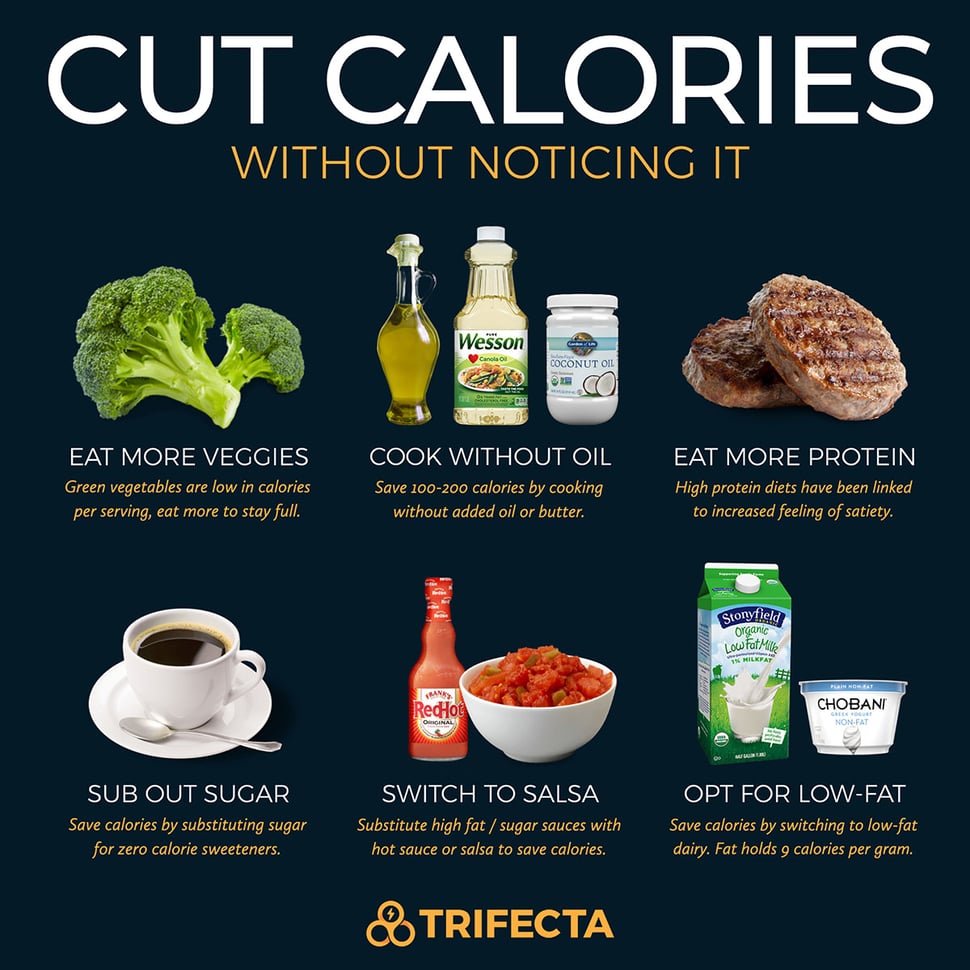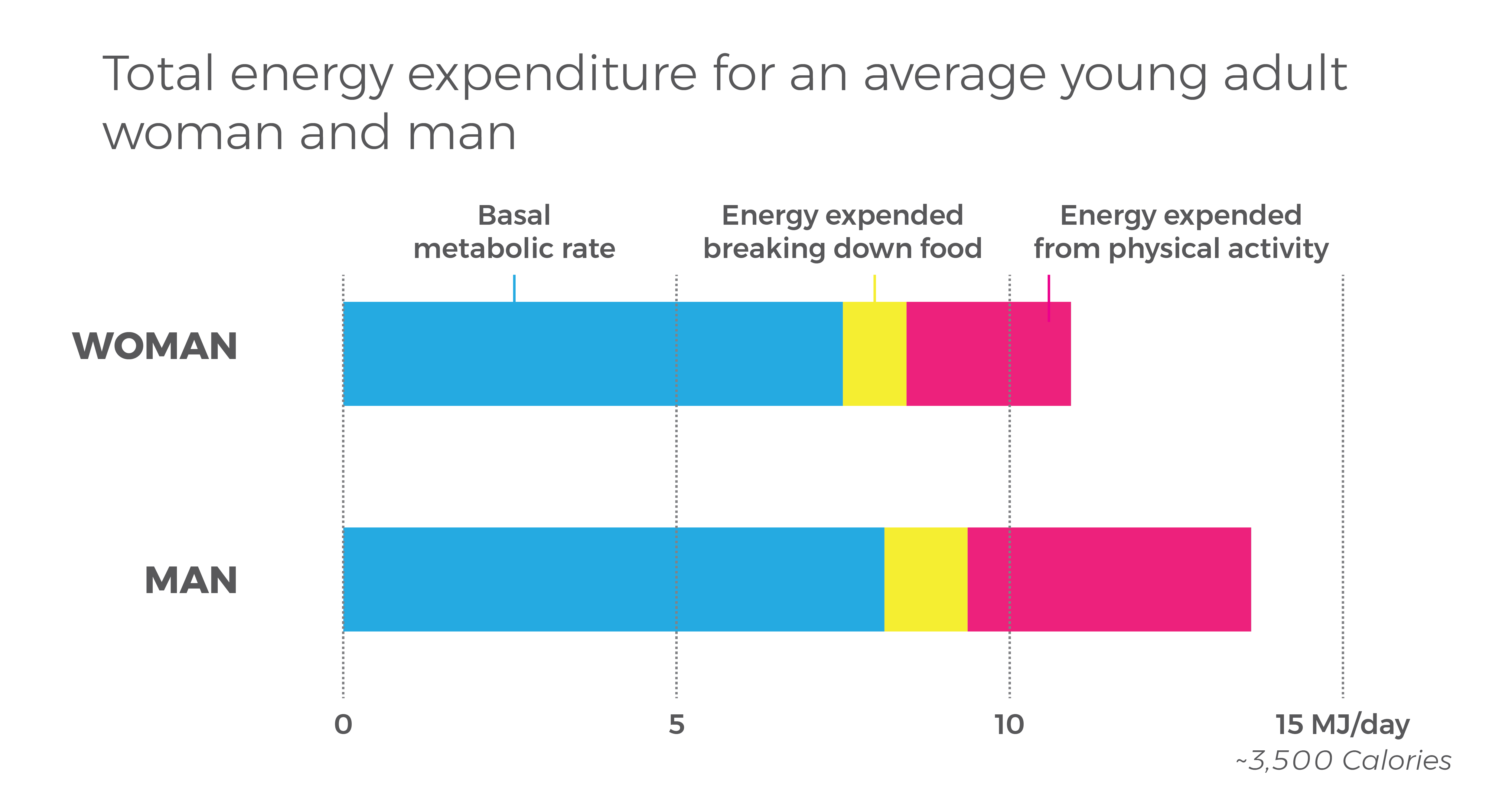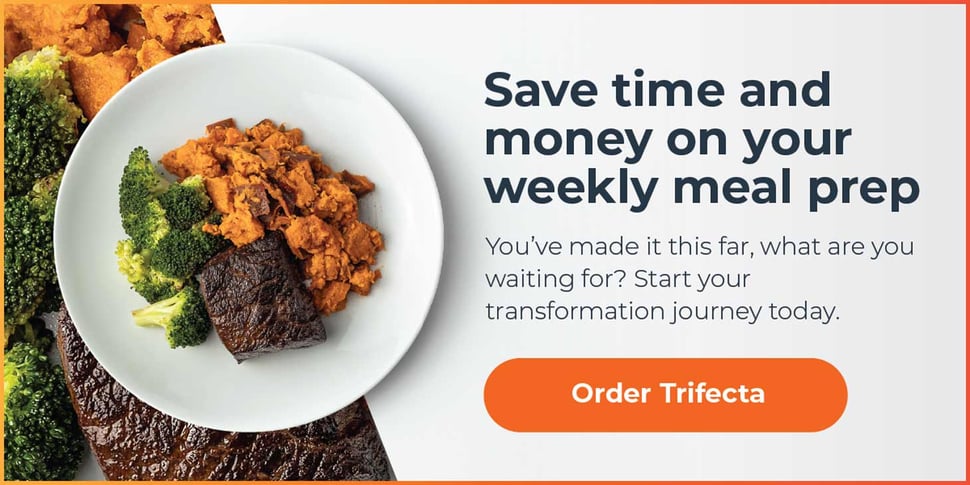What's the first thing someone tells you when you say you want to lose weight? Join a gym? Start running?
Often the first solution people give you to lose weight is to start exercising. While this has many benefits and can support weight loss efforts, it's entirely possible to achieve weight loss without exercise.
Don’t have time to fit in a workout most days? Or maybe you’re just not in a place physically to add workouts to your game plan. Don’t sweat it—literally!
Fitness is really just one part of the equation. So no matter where you are on your weight loss journey, here are the best science-backed ways to stay on top of everything else your body needs in order to accomplish your weight loss goals.
How to Lose Weight Without Exercise
Even though trying to lose weight can feel extremely difficult for many of us, the science behind how weight loss works is actually pretty simple—weight loss can only be achieved by eating fewer calories than you burn. In other words, the only thing you need to master to get results is a consistent calorie deficit.
Exercise can help you burn more calories each day, which can make creating this calorie deficit easier. However, it is entirely possible to create a calorie deficit just by reducing the amount of food you eat. In fact, diet is the most important part of the weight-loss equation and the easiest way to have an impact on your results.
For example, you can cut 200 calories a day from food by skipping out on dessert or a bottle of soda. Or you can burn 200 calories from running two miles or from a moderate 20-minute workout. Both are completely effective methods to achieve the same goal.
It can be much more difficult to consistently cut a large number of calories through activity alone (1,2). In addition, exercise typically represents only a small portion of your day and overall calorie expenditure—physical activity, or TEA and NEAT, only accounts for a small portion (10 to 30%) of your total daily calorie burn.
Source: Adapted from Frontiers in Physiology
This is exactly why you shouldn’t use exercise as an excuse to eat whatever you want—you cannot out-exercise poor nutrition. Changing your eating habits is the single most effective approach to calorie control, and exercise is typically supplemental to this.
Your goal to lose weight aside, movement is still important for health! Large studies from around the world have associated sedentary behavior with a variety of poor health outcomes, including increased mortality (3,4,5,6,7). Prolonged sitting has also been associated with an increased risk for diabetes, cardiovascular disease, and cancer (8,9).
If you physically aren't able to exercise, low-impact activities like walking or light housework can still greatly benefit your calorie burn and overall health. Try parking further away at the store or taking a walk on your lunch break, even if it's only 5-10 minutes can also be a form of exercise.
Is There a Magic Pill for Weight Loss?
I think we all know the answer to this by now, but it still gets asked all the time. Unfortunately, the answer is no. There isn't any weight loss pill, special diet, supplement, or secret approach that is going to support losing weight in a healthy, gradual way. Yes, pills may help you go to the bathroom and lose water weight quickly but this isn't true weight loss.
Losing weight in a sustainable way isn't something that someone or some product can guarantee will happen in a day, a week, or a month. If someone is promising you this, please run in the other direction.
The FDA warns that evidence to support weight loss pills is not convincing and expensive. There have also been hundreds of dietary supplements subject to lawsuits due to serious health complications and for this reason, the FDA maintains a running list of notifications regarding contaminated weight loss products. Oftentimes, these risks are regarding unapproved drugs or ingredients being used in these products (40).
Diet pills, detoxes, and cleanses are full of false promises that are likely to leave you feeling defeated and worse off than when you started. Keep in mind that if a diet claim sounds too good to be true, it probably is.
The most highly recommended strategy to lose weight amongst health professionals is lifestyle changes. These shouldn't be quick fixes but instead small shifts to adopt into your everyday life that becomes habits over time.
10 Ways to Cut Calories Without Breaking a Sweat
Regardless of how simple the calorie equation is, it is often easier said than done. Figuring out your exact daily calorie needs can be tricky. Then it takes a bit of strategy and practice to learn how to measure exactly how many calories you are eating each day. The fact is there are a lot of variables to account for.
And to make things even harder, cutting calories too low can do more harm than good. Being too restrictive can cause increased food cravings, decreased willpower, zap your energy, negatively impact your mood, lead to yo-yo dieting, and in some cases mess with your metabolism. So how exactly are you supposed to win this battle?
Here are 10 proven ways to master calorie control and drop some pounds without having to hit the gym or starve yourself:
1. Track Your Calories
In an analysis of the National Weight Control Registry, looking at those who lost a significant amount of weight and kept it off, researchers found that a majority of these people kept track of their food intake over long periods of time (multiple years) (10). This habit was shown to be beneficial regardless of the method or diet used to lose weight. And this finding has been supported by multiple other studies as well (11,12,13,14).
This makes sense since it’s almost impossible to master calorie control without tracking your food intake—this is the measurement of all the calories you take in and half of the weight-loss equation! Start by estimating how many calories you burn each day at rest. You can do this through an online calculator or when you log into most food tracking apps.
Then make it a habit to track all of your food and beverages every day, even for cheat meals or on bad days, holidays, and weekends. This will give you the best snapshot of how well your eating is going and is one of the best habits to build when it comes to better nutrition.
2. Count Macros
While you're tracking your calories, you should also consider counting macros or macronutrients.
Macros are really just your calories organized into three major food groups—protein, fat, and carbs. These food groups supply ALL of the calories you get from foods and beverages and also play a role in maintaining good health, managing hunger, keeping energy and mood high, and much more (15,16,17). So if you get into the habit of counting your macros, you’ll be able to balance your nutrition and count calories all at the same time. Win-win!
Similar to calories, you can estimate your daily macronutrient needs using an online calculator or when you log into a macro-friendly tracking app.
3. Use Portion Control
Studies suggest that most people underestimate their calorie intake by nearly 20% (18,19,20). This is mainly because they don't track everything consistently, or because they aren’t estimating serving sizes correctly.
Estimating your food intake will get you closer to your goals, but it really takes understanding portion sizes to get it right. If you’re eating out and enjoying foods without a nutrition facts label, it can be a challenge to guesstimate how many calories and macros you are consuming. And even if there is a nutrition facts label, eyeballing your portion size will only get you so far.
Instead of guessing, consider using measuring cups or take it one step further and learn how to weigh your food. Understandably, this can be difficult to do when you go out to eat but often restaurants have calories listed so you can use that information to have a better idea of the calories you're consuming based on if you eat 100%, 75%, 50%, etc., of your meal.
This will help get you the most accurate nutrition information and help ensure you are hitting your calorie goals more closely.
4. Decrease Empty Calories
Scaling back on portion sizes is one thing, but you can also make a few food swaps to cut calories without even feeling it. Empty calories come from those foods that supply energy to our bodies, but not a lot of nutrition. And research suggests that eating less of these foods can not only help you cut calories but may also make room for more nutritious choices (21,22,23).
This includes high-calorie junk foods, sugar-sweetened beverages, and some added ingredients. Take a look at your daily food log and see what sources of hidden or “extra” calories you are willing to eliminate or scale back on. Here are some easy examples:
- Use cooking oil spray instead of pouring oil when prepping your food at home
- Opt for baked and roasted options over fried
- Choose mustard on your sandwich instead of mayo
- Try thin-crust pizza instead of a pan or deep dish
- Swap creamy salad dressing for a vinaigrette

5. Eat a Satiating Diet
Increased appetite is a common side effect of reducing your calorie intake, which can be pretty counterproductive to the whole process if you give in too often. Luckily, there are certain foods you can eat more of that help control your hunger a little better.
One study found including plenty of foods high in protein, fiber, and a moderate amount of healthy fats resulted in two times the amount of fat mass loss compared to a healthy control diet (24).
High protein foods can come from animal sources like meat, seafood, and dairy, or plant-based sources like beans, nuts, legumes, tofu, etc. For fiber, turn to your fruits and veggies and whole grains. Healthy fats include avocado, nuts, and seeds to name a few.
Research also suggests that eating breakfast can help control hunger and calories all day long (25,26,27). There is strong evidence to support that a high-protein breakfast is beneficial for maintaining a healthy weight. This helps you to feel full longer in the morning so you don't feel like you're playing catch up with your appetite all day long.
6. Drink More Water
Drinking more calorie-free and hydrating beverages like water over other options can help you cut a lot of calories, especially if you drink a lot of soda or sweetened drinks currently. In addition, water may have some unique benefits when it comes to weight loss.
Water is important for a number of bodily functions including metabolism and digestion, meaning you need water to burn fat efficiently. Plus water helps fill you up. Some studies suggest that drinking a large glass of water before your meals may help you eat less (28,29,30). Try fruit-flavored water or carbonated water if you get bored with plain water to help you meet your hydration needs.
7. Get Some Sleep
Sleep plays a vital role in optimizing your body's daily functioning. It can be difficult to keep your willpower and your eating in check when you are running on little sleep. Lack of quality rest can mess with your metabolism and appetite-regulating hormones, signaling to your brain you need more energy in the form of food (31). And the type of food your body calls for is typically high-carb options for quick fuel, which means increased sugar cravings (32).
Aim to get at least seven hours of uninterrupted sleep each night and make rest more of a priority. Especially if you find yourself feeling stressed often. If you're choosing between a workout and adequate rest, your body and hormones will thank you more for the sleep.
8. Eat More Mindfully
There is growing evidence in support of mindful eating to lose weight, which is the practice of eating with more intention and awareness. Just slowing down and paying more attention to your food, and actually enjoying what you eat a bit more, can help you get in touch with your hunger fullness cues.
Studies have linked mindful eating to automatic calorie control, decreased food cravings, increased willpower and motivation, and better nutrition intake (33.34,35).
You can practice mindful eating by removing distractions when you sit down for a meal, aka put down your phone and turn off the TV. It can take some time but eventually, you will learn to pay more attention to all of your senses while you eat.
9. Find Balance
At the end of the day, the best diet for you is the one you can stick to—this means using a sustainable approach to losing weight with foods you actually enjoy eating.
Cutting too many calories too quickly or being super restrictive with your eating habits can lead to fast results, but you likely won't stick to it long term. And if you can't stick to it, the results will just leave just as quickly as they came. Striving to lose weight fast is not recommended and is not sustainable. This can turn into a yo-yo diet cycle that you want to avoid.
Not to mention restrictive eating causes increased cravings and uncontrolled hunger, and negatively impacts your nutrition, your mood, and your relationship with food (36,37,38,39).
Small changes can make a huge impact on your goals, especially when you use them to create healthy habits that stick. So instead of overhauling your life, figure out a healthy balance that works for you and commit to the long game. Start with goals you can master in a few weeks, like tracking your food intake, and then keep building on these goals until they become bigger goals. Before you know it, you will have transformed your health.
10. Use a Meal Plan
To simplify things, you can also have someone take care of the bulk of your nutrition needs by using a calorie-controlled meal delivery service that fits your needs to lose weight.
Pick a meal plan that meets your food preferences, or save money and build your own meals using a la carte ingredients. Then sit back and wait for your delivery each week. When the food comes, just heat and eat and add in any extra snacks or meals you want to fit your calorie goals.
Getting the bulk of your nutrition and macros covered also means there’s less stress when it comes to sticking to your diet, which can increase your motivation and willpower, and remove the guilt that comes along with failing some days. This also means more time to build other healthy habits, like tracking your food intake, getting plenty of rest, or going for a long walk.
How to Make Your Weight Loss Last
Often times we get the inspiration to lose weight with things like summer approaching and the thought of putting on a swimsuit or a special event on the horizon but once those events happen and our goal is met or the event happens, we slip back into our old habits and routine.
We've discussed strategies to lose weight without exercise, and now you want to focus on how to maintain your weight once you do get to where you want to be. Here are some strategies to keep your health at the top of your priorities:
- Continue your new routine and habits. There's a reason we emphasized making small gradual changes that you can stick to for the long term. This means continuing the steps we talked about earlier like eating satiating meals, getting adequate sleep, and staying hydrated.
- Recalculate your calorie and macro needs based on your goal for maintenance vs weight loss. This will likely bump up your numbers so you don't find it as challenging to stick to making healthier choices.
- Weigh yourself weekly. This will help you make adjustments if the scale starts moving in the opposite direction. If it is triggering for you to focus on weight, another strategy is being mindful of how your clothes are fitting.
When making any changes to accomplish your goals, remember that you don't need to be perfect. If you are choosing nutritionally focused and balanced meals most of the time you don't need to dwell on what happens at one meal or one day that doesn't go as planned. Progress over perfection is always the goal.





